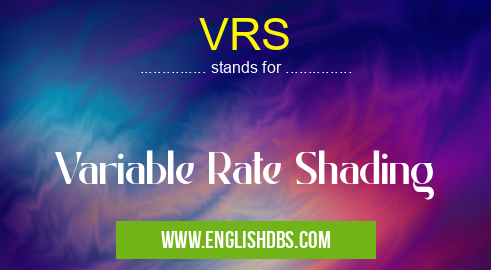What does VRS mean in UNCLASSIFIED
VRS stands for Variable Rate Shading, a graphics technology that allows game developers to optimize the performance of their games by varying the shading rate across different parts of the screen. This allows for more efficient use of GPU resources, resulting in improved frame rates and reduced latency.

VRS meaning in Unclassified in Miscellaneous
VRS mostly used in an acronym Unclassified in Category Miscellaneous that means Variable Rate Shading
Shorthand: VRS,
Full Form: Variable Rate Shading
For more information of "Variable Rate Shading", see the section below.
Introduction to Variable Rate Shading (VRS)
How VRS Works
VRS divides the screen into small regions called quads. Each quad can be assigned a different shading rate, which determines how many times the shading operations are performed for that region. Areas of the screen with less detail can be assigned a lower shading rate, while areas with more detail can be assigned a higher shading rate.
Benefits of VRS
Using VRS offers several benefits:
- Improved Performance: By reducing the shading rate in less detailed areas, VRS can free up GPU resources that can be used to improve performance in other areas of the game. This can result in higher frame rates and reduced latency.
- Reduced Power Consumption: VRS can help reduce power consumption by reducing the number of shading operations required. This is especially important for portable devices and VR headsets.
- Improved Image Quality: In some cases, VRS can actually improve image quality by reducing aliasing and other artifacts. This is because the lower shading rate in less detailed areas can help to smooth out these imperfections.
Conclusion
VRS is a powerful graphics technology that can significantly improve the performance and image quality of games. By varying the shading rate across different parts of the screen, VRS allows game developers to optimize the use of GPU resources and reduce latency. As VRS becomes more widely adopted, we can expect to see even more benefits from this technology in the future.
Essential Questions and Answers on Variable Rate Shading in "MISCELLANEOUS»UNFILED"
What is Variable Rate Shading (VRS)?
VRS is a graphics technology that dynamically adjusts the shading rate of different parts of a 3D scene based on their visual importance. It allows developers to allocate more shading resources to areas that require it, such as highly detailed objects or areas of motion, while reducing shading in less noticeable areas to improve performance.
What are the benefits of using VRS?
VRS offers several benefits, including:
- Improved performance: By reducing shading in less important areas, VRS frees up GPU resources, enabling higher frame rates and smoother gameplay.
- Increased visual quality: By allocating more shading resources to important areas, VRS enhances visual detail and realism.
- Reduced power consumption: By optimizing shading, VRS helps reduce the power consumption of graphics cards, extending battery life on portable devices.
How is VRS implemented?
VRS is implemented through hardware support in modern graphics cards. It works by dividing the screen into tiles and dynamically adjusting the shading rate for each tile based on factors such as object density, motion, and lighting.
What types of games and applications benefit from VRS?
VRS is particularly beneficial in games and applications that involve complex 3D scenes with a high level of detail and motion, such as first-person shooters, open-world RPGs, and simulation games.
Is VRS compatible with all graphics cards?
VRS is currently only supported by modern graphics cards that have hardware support for the technology, such as NVIDIA's RTX series and AMD's Radeon RX 6000 series.
VRS also stands for: |
|
| All stands for VRS |
